Typically, you’ll find more hummingbird species in the Southwest and along the western coast of the United States. But in recent years, sightings of more species of hummingbirds in Michigan have occurred. Most commonly, you’ll spot the expected ruby-throated hummingbirds and rufous hummingbirds, but it’s possible to see up to 9 different species in the state.
Read below to learn about these beauties, as well as when to spot them and where in Michigan you might find them buzzing about. Plus, learn how to attract them to your yard.
Ruby-throated Hummingbird

Ruby-throated hummingbirds migrate to eastern North America in the spring, building nests in Michigan. They frequent backyards and often may even be hand-fed by humans.
©CounselorB/Shutterstock.com
The most common species of hummingbird spotted in the Midwest portion of the United States goes by the name of ruby-throated hummingbird. These beautiful green birds with blazing red throats buzz around gardens all over the eastern half of the country and frequently land in gardens throughout Michigan.
- Scientific name: Archilochus colubris
- Lifespan: 5 to 7 years, maximum record of 9
- Size: 2.8 to 3.5 inches
- Weight: 0.07 to 0.2 ounces
- Wingspan: 3.1 to 4.3 inches
- Conservation status: Least concern
Male ruby-throated hummingbirds come in shimmery, iridescent green shades with vivid ruby-red throats, earning the species their common name. Narrow borders of velvety black feathers edge the ruby patch on their throats, while a forked black tail may sparkle with a light purple sheen. Female ruby-throats bear speckled white throats with possible dusky streaks.
These amazing hummingbirds speed their way from the Gulf of Mexico each year during migration, all the way up to Michigan, some 500 miles nonstop. Typically, they appear the first week of May each spring and leave around the end of September.
Ruby-throats aren’t particularly known for their songs, but you still may hear their twittery, chirpy calls while they boldly buzz around the backyard. They love nectar from flowers as well as backyard feeders. They may even build a nest there. However, naturally, these beautiful birds are more inclined to look for deciduous woodlands, meadows, orchards, and forest edges to plant their tiny nests.
While they are concerned a “least concern” conservation species, their numbers have been slowly declining since 2004, when lower numbers started to be reported. Likely threats to the species include unsanitary bird feeders, window collisions, habitat loss, predation by fetal and domestica cats, climate change, and pesticides used on plants the birds use for food and roosting.
You may spot ruby-throated hummingbirds in Michigan anywhere their preferred habitats may be found, as well as gardens.
Anna’s Hummingbird
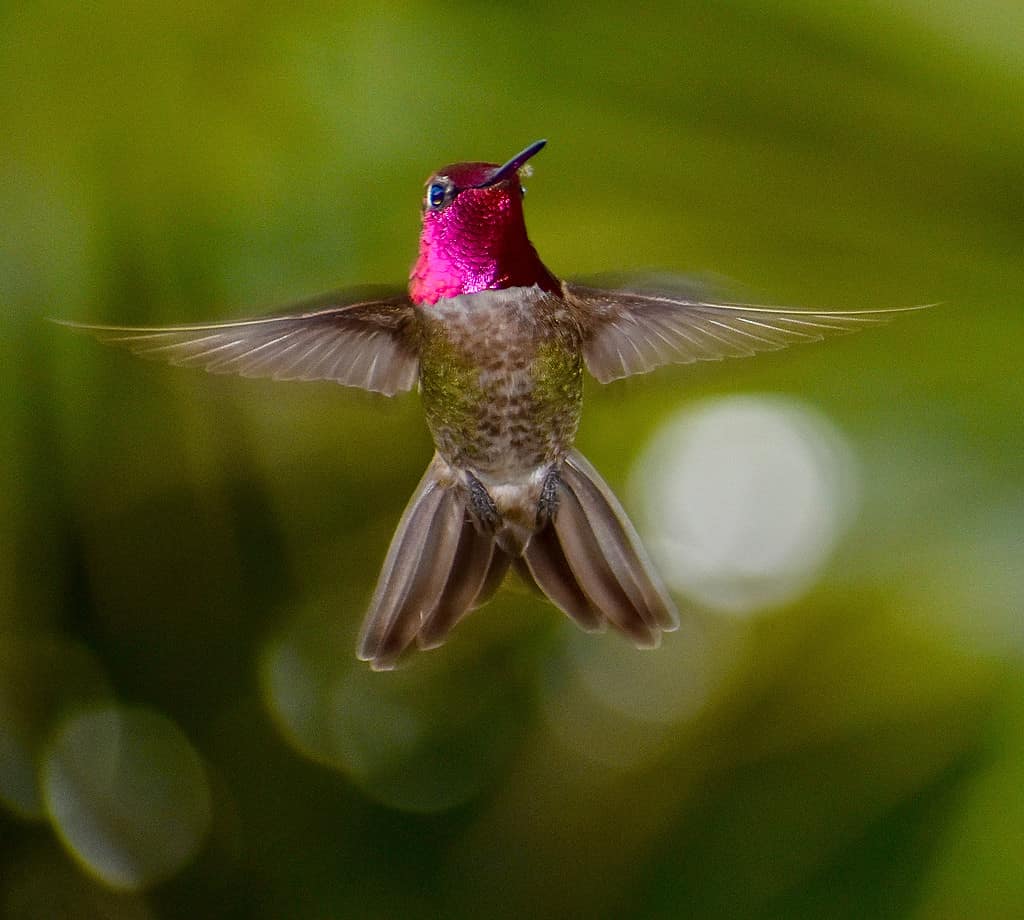
Observe the exquisite, stunning colorful male Anna’s
hummingbird
with bright iridescent pink magenta head wings out hovering. These birds occasionally make their way into Michigan.
©Rachelle007/ via Getty Images
Considered an accidental, or non-native, species of hummingbird in Michigan, the Anna’s hummingbird may occasionally be spotted here. The beautiful birds come in mostly green and gray, though male heads and throats dazzle in shimmering red-to-pink shades. Female throats are gray with red spotting.
- Scientific name: Calypte anna
- Lifespan: 3 to 12 years
- Size: 3.9 to 4.3 inches
- Weight: 0.1 – 0.2 ounces
- Wingspan: 4.7 inches
- Conservation status: Least concern
The unusual bird to make its way to Michigan, Anna’s hummingbirds generally travel a short distance during winter but don’t technically migrate. They more commonly live along the Pacific Coast and sometimes wander eastward during cooler months.
These stunning birds have earned a reputation for their dive-bomb displays during courtship. Males fly up to 130 feet in the air, then dive toward the earth with a burst of noise coming from their tail feathers. Once they mate, their nests find perch high in trees from 6 to 20 feet in the air, with between 2 and 3 broods each year.
These stunning hummingbirds in Michigan are usually spotted in backyards with large, colorful blooms, nectar feeders, and in scrub and savanna areas out west. Sadly, these beauties have only been spotted in Michigan a few times.
Rufous Hummingbird
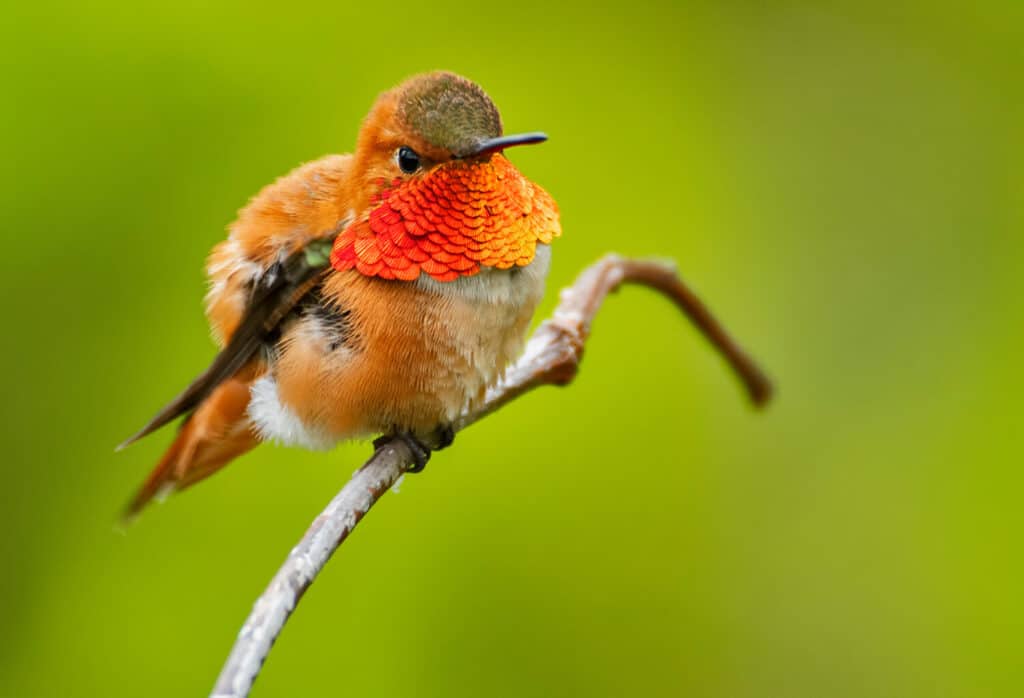
Rufous hummingbirds
are the second most common species of hummingbird in Michigan. These beautiful birds show off their vivid colors in mating rituals.
©punkbirdr/Shutterstock.com
Covered in shimmering, rusty orange feathers, or rufous colored feathers, the Rufous hummingbird is known to reside in Michigan. These stunning birds bear bodies mostly in reddish-orange, iridescent throats, green backs, a white breast, and rufous face, tail, and flanks. Tail feathers also come in dark shades, with a rufous base and white tips.
- Scientific name: Selasphorus rufus
- Lifespan: 8 years (maximum recorded)
- Size: 2.8 – 3.5 in
- Weight: 0.071 – 0.176 oz
- Wingspan: 4.3 in
- Conservation status: Near-threatened
Female Rufous hummers are slightly larger than males, with paler rust-colored flanks and green backs, green tails, and often a spot of orange on their throats.
These near-threatened tiny birds frequently visit Michigan during their long migratory journey each year. They have the longest migration journey of all hummingbirds in the United States, often making trips over 4,000 miles in length. During these incredible flights, they cross mountains and forests as high as 12,600 feet. These feisty birds are known to attack other hummingbirds and larger species around primary food sources, so beware!
Rufous hummingbirds make their appearance in Michigan in early May and leave at the end of September.
Broad-billed Hummingbird

Broad-billed Hummingbirds in Michigan aren’t the most frequent visitors, but they may be seen at times. Their vivid coloration helps make them easily identifiable.
©Monir Hossain/iStock via Getty Images
Coming in stunning, iridescent bright green, broad-billed hummingbirds in Michigan aren’t the most frequent but not entirely rare, either. The males of the species come in vivid green, with blue throat patches and black-tipped red bills. Females bear lime-green feathers on their backs with gray to brown feathers below, with a white eyestripe, and the same black-tipped red bill.
- Scientific name: Cynanthus latirostris
- Lifespan: 9 years (maximum recorded)
- Size: 3.1 to 3.9 inches
- Weight: 0.1 ounce
- Wingspan: 5.1 inches
- Conservation status: Least concern
This species rarely makes its way to Michigan, making them accidental vagrants in the state. They’ve only been spotted in southern Michigan. They’ll be spotted between July and December, though, when they are around. They often cock their tails as they sip nectar from tubular flowers, meaning they’re long-tongued hummingbirds. They appreciate nectar feeders, as well, but more strongly favor natural flower sources for their sweet nectar.
The beautiful males hover about 1 foot away from females when they’re courting, flying back and forth in pendulum motion. They often give a rapid chatter call, as well.
Broad-billed hummers natively reside in Mexico and the southwestern United States, inhabiting deciduous woodlands and forests along streams or near canyons. Their nests usually rest about 3 feet off the ground, in drooping branches or in rocky outcrops near water. They particularly favor red and yellow flowers, so if you want to attract the strays that make it into your neck of woods, feature these bell-shaped flowers in your garden.
Mexican or Green Violetear Hummingbird
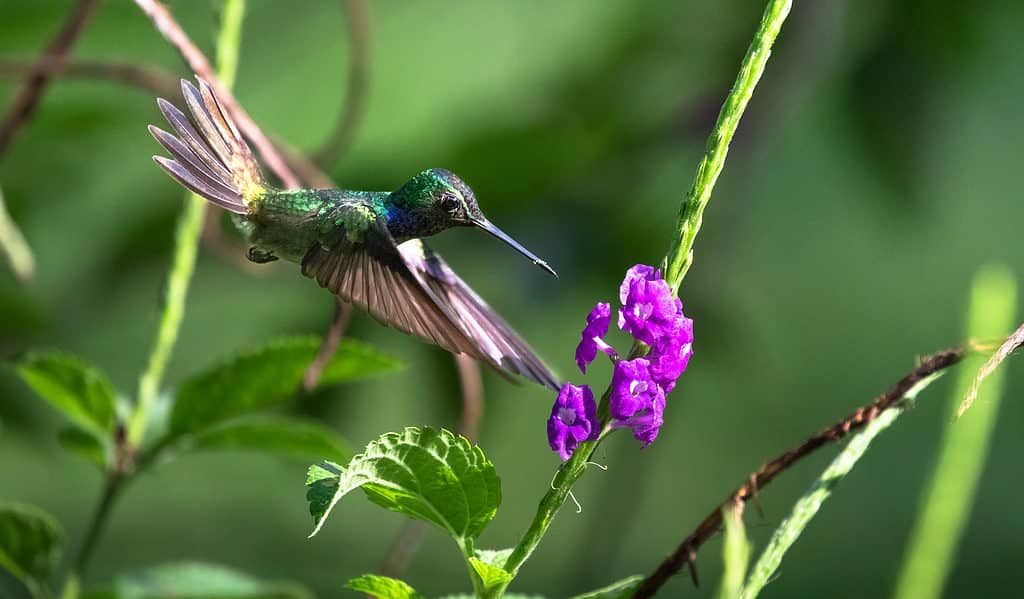
Mexican violetear is a beautiful hummingbird that occasionally makes its way into Michigan. Usually, this happens when weather patterns change, food dries up, or temperatures drop unusually.
©iStock.com/Kevin Wells
The vibrantly colored green violetear hummingbird, both male and female, lives up to its name. The bird comes in bright emerald green, shiny, and jewel-like, with slightly bronze coloration in their upper tail feathers and rumps. They bear violet to blue patches on the sides of their necks, earning the “violetear” part of their name. Their tails are green, notched, and squared off, while their bills are long and black, with a downward curve.
- Scientific Name: Colibri thalassinus
- Lifespan: 12 years (maximum recorded)
- Size: 2.5 to 4.5 inches
- Weight: 0.17 to 0.2 ounces
- Wingspan: 4.7 inches
- Conservation status: Least concern
These gorgeous birds are accidental vagrants swooping into Michigan on rare occasion, with only a handful of sightings during summer months. Generally, they stay in Central America and Mexico where they keep warm. They do have some seasonal spreading, though, which is when they make their way into Michigan and as far north as Canada.
White-Eared Hummingbird

White-eared hummingbirds have distinctive white eyestripes that help folks identify them. They don’t commonly live in Michigan, but there have been sightings.
©Gerardo Aguilar Anzures/Shutterstock.com
Green backed and breasted, with black heads and white eyestripes, white-eared hummingbirds are some of the most beautiful tiny birds in the world. They have long red bills with black tips. Males have violet and black faces, turquoise-green throats, and bronze-green tails. The females are duller in color.
- Scientific Name: Basilinna leucotis
- Lifespan: 3 to 12 years
- Size: 3.9 to 5.4 inches
- Weight: 0.11 to 0.14 ounces
- Wingspan: 4 to 5 inches
- Conservation status: Least concern
These, too, are accidental visitors to Michigan, and more rarely seen than most others. Only a handful of confirmed sightings have occurred in the past two decades. More often, they are found in Nicaragua, their native home, up to southwestern United States. They nest between March and August in northern areas (read: Michigan, when they are seen!) and produce up to 3 broods per year. They migrate south again by early September.
White-eared hummingbirds mainly reside in backyards with shrubs and low trees when in urban and suburban areas, but more commonly build homes in scrubby growth and forests, particularly pine-oak mountain forests and pine-evergreen woods.
Costa’s Hummingbird
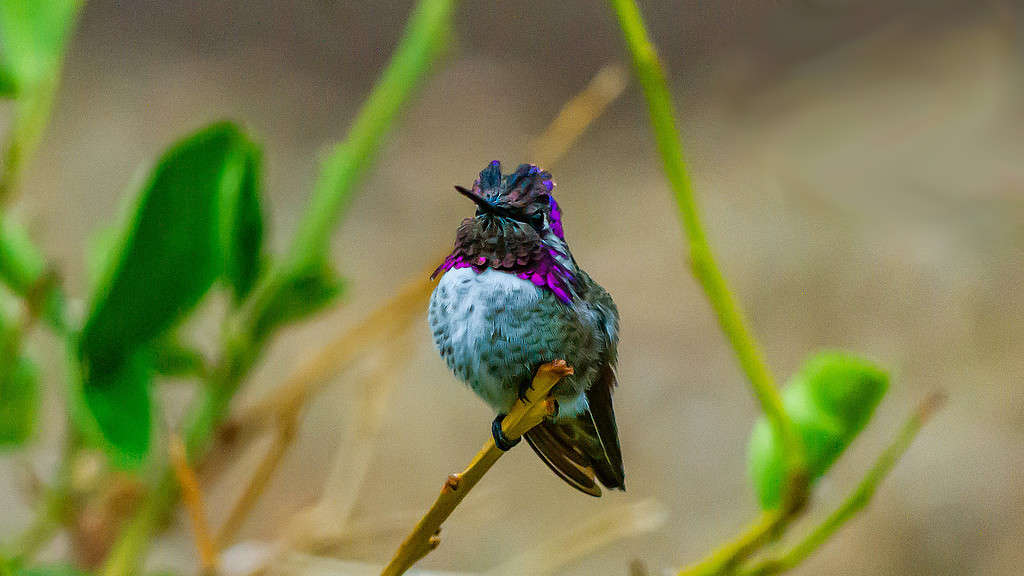
Costa’s Hummingbirds typically reside in desert terrains, using their vivid purple heads and muted bodies to blend in with desert flowers. Occasionally, though, they have been known to make their way to Michigan.
©Peter Milota, Jr./ via Getty Images
With green backs and sides, and white bellies, Costa’s hummingbirds have one of the brightest and most obvious heads of hummingbirds. The vivid, iridescent purple heads or crowns and throat patches help these tiny birds truly stand out. Yet, they blend in naturally like the desert flowers of the native home.
- Scientific Name: Calypte costae
- Lifespan: 9 years (maximum recorded)
- Size: 3 to 3.5 inches
- Weight: 0.11 ounces
- Wingspan: 3 inches
- Conservation status: Least concern
Costa’s hummingbirds reside primarily in desert lands like Baja, California, southern California, and southwestern Arizona. They do occasionally find their way up to Michigan, though, with a few confirmed sightings. They generally migrate between the Pacific Coast of Mexico in winter, then up to California and Nevada or Utah for breeding season. But, occasionally, they meander eastward due to weather patterns or unusual circumstances like low food or excessive heat.
Their native environment calls for deciduous forest, desert scrub, and chaparral for nest building, but they’ll also build in low shrubs, just 3 to 7 feet off the ground. Costa’s hummers may produce up to 2 broods per year.
Berylline Hummingbird

Berylline hummingbirds are some of the most colorful hummers in the world. They rarely make their way to Michigan.
©Wang LiQiang/Shutterstock.com
Metallic green birds, with grow bellies and reddish wings, Berylline hummingbirds occasionally make their way into Michigan. Males are slightly larger than females, but both have black upper bills and red-orange lower bills. Their heads have bright, iridescent green-turquoise heads, throats, and chests, with reddish tails that may have a purple sheen.
- Scientific Name: Saucerottia beryllina
- Size: 3.1 to 3.9 inches
- Weight: 0.14 – 0.17 ounces
- Wingspan: 5.75 inches
- Conservation status: Least concern
These accidental visitors to Michigan usually range from Mexico to Honduras, straying up to southern Arizona. These are usually solitary birds, with aggressive behavior defending their territory. They likely will include the local hummingbird feeder as territory and fight off other species and Beryllines from using what they’ve claimed. They prefer open woodlands of pine and oak, or canyons with shade, though, rather than backyards.
How to Attract Hummingbirds to Your Backyard
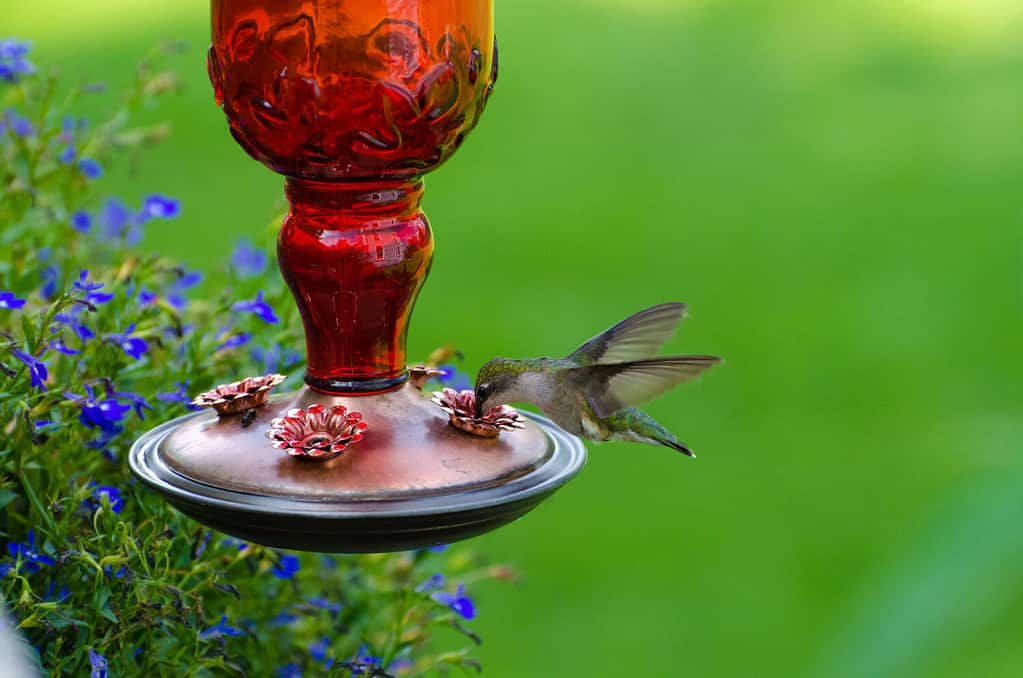
Provide your hummingbirds in Michigan with plenty of hummingbird feeders spread throughout the yard. This helps to attract more birds to the yard.
©redtbird02/Shutterstock.com
While you’re not super likely to draw in the rare (accidental) visiting Costa’s hummingbirds of Mexican violetear hummers, you can still aim to attract these beauties and their more common counterparts. Several things may be done in the backyard to attract hummingbirds in Michigan without a lot of effort or expense.
- Grow native flowering plants like salvias, fuchsias, trumpet creepers, and lupins. These will attract these nectar eaters looking for delightful, sweet nectar and the insects perched within their petals.
- Skip the herbicides and pesticides, as they’re toxic for birds. Instead, find natural solutions.
- Add small perches like thin branches without leaves, tiny human-made perches, and other places for hummers to rest.
- Provide non-dyed hummingbird nectar in clean, well-maintained hummingbird feeders. Feeders should be changed and thoroughly washed every day in temperatures over 90 degrees F, or every 2 to 3 days when temperatures are around 60 to 65 degrees F.
- Spread out the hummingbird feeders, allowing multiple birds to come in without expecting a dual.
- Add a hummingbird-friendly water feature, like a small birdbath or stream. Keep the water running to prevent stagnation.
Best Flowers to Attract Hummingbirds in Michigan

Trumpet Honeysuckle (Lonicera sempervirens) in full bloom offers hummingbirds in Michigan exactly what they’re looking for. Loads of nectar, trumpet-shaped flowers, and bold red and yellow coloring.
©shepherdsatellite/Shutterstock.com
A few key factors will attract hummingbirds to the flowers in your backyard.
- Focus on tubular flowers to attract hummingbirds instead of other pollinators like bees and beetles.
- Plant yellow and red flowers. Most hummingbird species love these colors.
- Provide flowers that produce a lot of nectar.
- Ensure the flowers are native or naturalized to Michigan.
Some of the best flower species to grow in your hummingbird garden in Michigan include:
- Trumpet vine (or trumpet creeper)
- Sage (salvia)
- Lupine
- Columbine
- Trumpet honeysuckle
- Bee balm
- Red cardinal flower
- Beard tongues
- Coral bells
- New Jersey tea
- Fireweed
- Phlox
- Rose of Sharon
- Golden currant
- Flowering tobacco
- Petunias
- Orange jewelweed
- Impatiens
- Anise hyssop
- Dense blazing star
The photo featured at the top of this post is © punkbirdr/Shutterstock.com
Thank you for reading! Have some feedback for us? Contact the AZ Animals editorial team.






